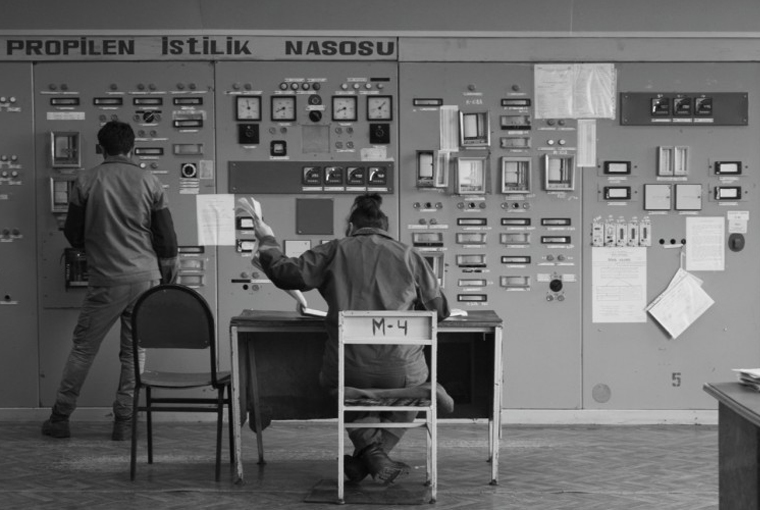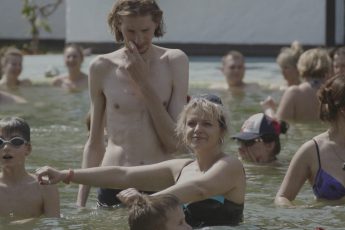The Oil is Black, the Spoon is White
Laila Pakalniņa’s Spoon (Karote, 2019)
Vol. 96 (Summer 2019) by Zoe Aiano
In English at least, the word “spoon” conjures up a universe of evocations. It is perfectly satisfying both as a noun and a verb, in each case encompassing both the mundane everyday and the comfortingly familiar. Notable achievements in the contemporary usage of the word “spoon” include its crucial role in L. P. Hartley’s classic novel The Go-Between, in which the narrator is traumatized for life after witnessing “spooning” in the barn, and its inclusion in the great British lexicon of terms of endearment disguised as insults. The spoon world patchworked together by Laila Pakalniņa’s experimental documentary of the same name tends more towards the dystopian, yet clearly the choice of this particular object as emblematic of Late Capitalism is somehow rooted in these associations of absurd banality.
The underlying message of the film is ecological and political. Tracing the production of a bog-standard disposable white spoon, it follows the process as a whole, from the extraction of the oil used as the base material to the manual quality checks carried out on the individual finished items. Crucially, this creation is not shown chronologically from earth to earth (or rather, from earth to landfill). Instead, snapshots of each step are montaged together, with no contextualization, no explanation and no commentary. Indeed, almost every shot is a wide, static testament to the monumental domination of industry, with all human and natural presence wordlessly serving its mechanisms. The film jumps from country to country and context to context, often the only clue for identifying the specific location coming from the language of the signs indicating instructions and warnings (except in cases where the ubiquity of English as the language of capital prevails).
In this way, Pakalniņa creates a kind of paradoxically ubiquitous non-place. Physical and political geography is fragmented and recomposed to form a cohesive whole that is all-encompassing, omnipresent and also in a constant state of perpetuation. The eponymous spoon only appears in recognizable form towards the end of the film, adding to the sense of abstraction and distance from the purely social sphere. Indeed, the punchline to the film is provided by its very structure – the production lasts for an eternity and travels across continents, only for the use to be over and done within a few brief moments.
In order for the film to remain watchable for those who do not have a fetish for staring at endless shots of anonymous blocks of concrete and steel, the creation of rhythm plays an important role. While the camera itself never moves from its post and the individual takes can last for minutes, the action within the frame establishes a certain tempo, with massive vehicles lumbering along their tracks and workers speedily and precisely repeating their required actions. Indeed, there are certain resemblances that justify its interpretation as a modern take on the “city symphony” films of the early twentieth century, especially the work of Dziga Vertov. This reading also adds to the poignancy of the film – in the space of a hundred years, we have not only achieved the mechanization of workforces and globalization of industrial infrastructure desired by the intellectuals of that time, but rather we have surpassed all expectations, only to discover the disastrous effects for society and the planet.
This is also accentuated by the soundtrack, which is heavily industrial and was purposefully sculpted to blend in with and become indistinguishable from the diegetic noises of the machines. There is also a subtle hint of humor and playfulness in the score, which somehow manages to seep into the imagery despite the heavy nature of the content, in keeping with the inherent and unavoidable comedic value of the spoon. One of the ways this emerges is through the inclusion of occasional instances of people reacting to the film, which breaks the aesthetic somewhat yet restores just enough humanity to stop the film from being too cold.
Pakalniņa’s Spoon offers a prime example of the value of making a single point and making it well. Of course, the point doesn’t change from the start to the finish, but this insistence is justified by the need to emphasize the inconceivable magnitude underpinning single-use cutlery. The film doesn’t tell us anything we don’t already know – some of the physical processes and specific locations may be unfamiliar to audiences going into the cinema, but they won’t be much more enlightened coming out of it again. What it does offer is a cinematically interesting and formally effective perspective on the apparatus underpinning not only modern global industry but also our social interactions more generally. If nothing else, it will be hard to look a plastic spoon in the face for some time after watching it.




Leave a Comment